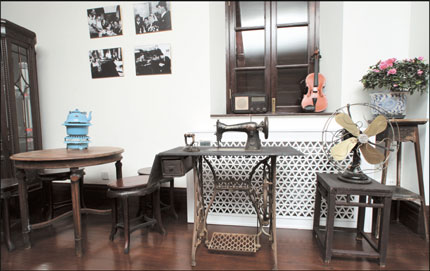Famed synagogue now a museum
Tilanqiao area, once known as Little Vienna, in Hongkou District, has survived war and urban renovation and its remarkable story may be its salvation as Shanghai weighs the value of historical preservation.
In the late 1930s during World War II, more than 20,000 Jews fleeing Nazi rule arrived in Shanghai. Drawn by its open-door policy, they joined earlier waves of Jewish migrants to the city.
Later, during Japanese invasion, Jewish refugees were confined to Tilanqiao's brick tenements, but spared further repression.
The Shanghai Jewish Refugees Museum on Changyang Road was built in memory of that period of time. It is housed in the former Ohel Moshe Synagogue and holds many scrolls, other cultural relics and items from that period of time.
|
|
|
Furniture and articles from refugee families are exhibited at the Shanghai Jewish Refugees Museum on Changyang Road. [Shanghai Daily] |
The original Ohel Moshe Synagogue was founded in 1907 and moved to its current site in 1927. It was a synagogue for Orthodox Russian and German Jews. The synagogue was also once the headquarters of the Jewish Youth Organization.
Between 1937 and 1941, Shanghai was one of the few big cities that did not reject Jewish refugees.
"Ohel Moshe Synagogue" became a synonym for "rescue" and "refuge."
The Jewish refugees lived a peaceful life around the synagogue, trying to recreate some aspects of Viennese culture. After the war many emigrated all over the world and the city's Jewish population dropped to almost zero.
In the autumn of 1986, a group of Jews who once lived in Shanghai revisited the place. Grateful to the people of Shanghai for providing refuge, they presented a plaque to the district government, inscribed, "20,000 Jewish refugees survived in Shanghai during the Second World War. To all the survivors and friendly Chinese people we dedicate this plaque."
Former Israeli Prime Minister Yitzhak Rabin visited the museum in 1993. He left these words in the guest book, "The Jewish people were protected by Shanghai people when they were murdered and driven out by Nazis and wandered in the world. The Israeli government, Jewish people and I thank them for their help from the bottom of our heart."
Being an important part of Shanghai Jewish heritage, in early 2004, the former Ohel Moshe Synagogue was recognized as an important historic building. Hongkou District declared it to be a protected cultural relic site.
Now, converted into the Shanghai Jewish Refugees Museum, the three-story gray-and-red brick building has been restored to its original state. It overlooks residences and shops of the former "Hongkou Ghetto."
The first floor houses the sanctuary where visitors can see the original mosaic floors and the ark. The walls and pillars of stone-arched door way have been repainted.
The old furnishings are gone. Seats and hanging lamps have been added. Old pictures of Jewish halls and houses built by Jewish tycoon David Sassoon hang on the walls. Next to the sanctuary, in the synagogue's former kitchen, is a showroom for Jewish art exhibits.
The second floor is divided into two rooms. One contains a gallery of photos and stories from the ghetto along with photos of former Jewish residents who returned for visits. More than 100 photos and sculptures are displayed; a short movie detailing Jewish history in Shanghai plays on a multi-screen system.
The second room, with a large conference table and books on the history of Jews in China, was the location of a private "classroom."
The third floor exhibits articles from refugee families, furniture and a brief account of a Mr Levinsky, who lived in the room in the 1930s.
The museum is further developing the third story with more interactive content. An interactive database was launched in June 2008 to complete the name list of Jewish refugees in the Tilanqiao area. So far, 14,800 names have been stored in the database.
The names include those that museum management collected from memoir books and historical materials as well as those supplied by overseas visitors to the museum. A computer linked to the database is available for free use.
The Shanghai Jewish Refugees Museum has been collecting more artifacts and artwork from Shanghai and foreign countries since 2007 to enrich the exhibits and better document this period of city history.
"Witnesses to this history, including the Jews who used to live in Shanghai and the old Shanghai residents, are passing on. So we need to gather precious historical evidence such as photos and papers as quickly as possible to add to our exhibits," says Chen Jian, the museum's curator.
Opening hours: 9am-5pm
Address: 62 Changyang Rd (near Zhoushan Rd)
Admission: 50 yuan
Tel: 021-6541-5008
 0 Comments
0 Comments







